What Are the Key Benefits of Self-Service Solutions for Businesses and Customers
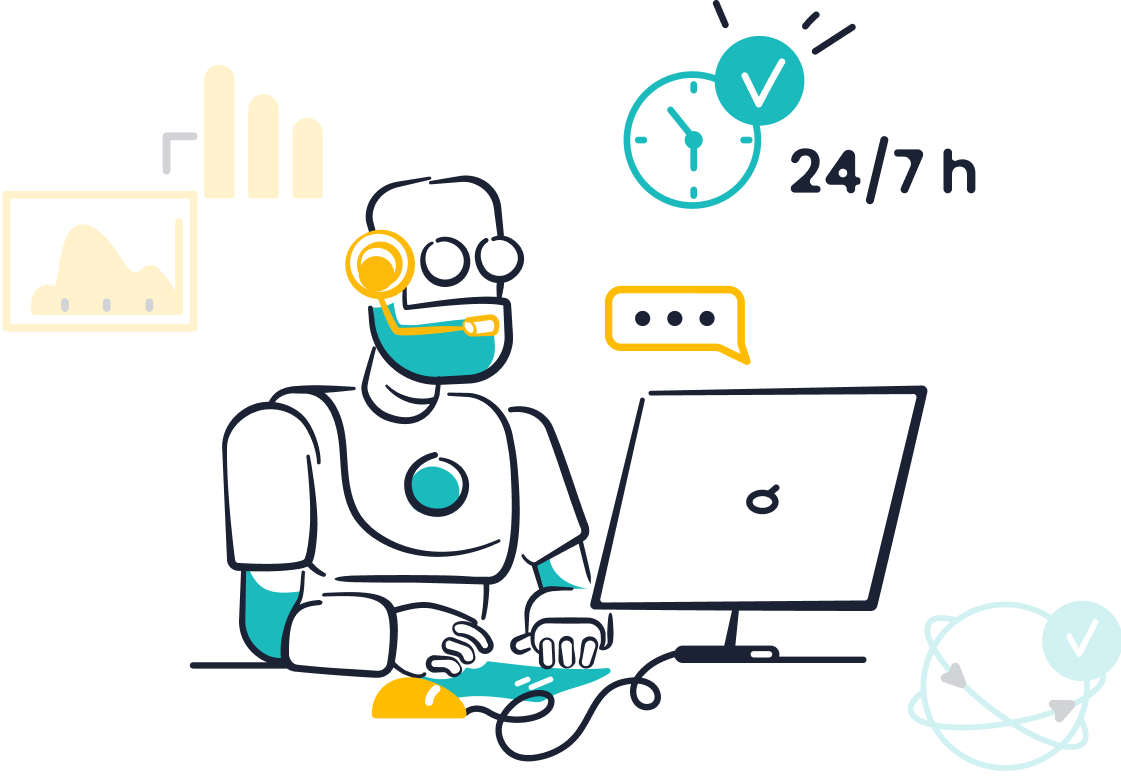
Imagine solving your own problems without waiting on hold or navigating endless phone menus. That’s the magic of self-service solutions. It’s transforming how you interact with businesses by giving you control and saving time. Did you know 75% of customers say quick responses are the key to great service? Plus, companies save big—automated interactions cost just 25 cents compared to $6-$12 for live agents. Tools like Sobot’s chatbot make this possible, helping businesses cut costs while empowering customers to find answers anytime. Self-service solutions aren't just a trend; they're a game-changer.
Understanding Self-Service Solutions
What Are Self-Service Solutions
Self-service solutions let you take control of your interactions with businesses. Instead of waiting for help, you can find answers or complete tasks on your own. These solutions have come a long way. They started as simple FAQ pages but now include advanced tools like AI-powered chatbots and self-service kiosks. For example, Emirates uses intelligent kiosks to streamline customer service, while Wavetec’s kiosks at Union Station in Toronto allow instant SIM card issuance. This evolution shows how businesses are making it easier for you to get what you need, faster.
The global market for self-service technology was valued at $28.14 billion in 2021 and is expected to grow by 6.7% annually through 2030. This growth reflects how much businesses and customers value these tools. Whether it’s a chatbot answering your questions or a kiosk helping you complete a transaction, self-service solutions are all about convenience and efficiency.
Common Types of Customer Self-Service Tools
You’ve probably used customer self-service tools without even realizing it. Here are some common examples:
- Self-service kiosks: Found in airports, malls, and even hospitals, these kiosks let you check in, make payments, or get information instantly.
- Chatbots: Tools like Sobot’s AI Chatbot provide 24/7 support, answering your questions and guiding you through processes.
- Knowledge bases: Online libraries filled with articles, FAQs, and guides help you solve problems on your own.
- Mobile apps: Many businesses offer apps that let you manage accounts, schedule appointments, or track orders.

These tools are designed to save you time and make your experience smoother. For instance, Sobot’s chatbot not only answers questions but also helps businesses cut costs by automating repetitive tasks.
Why Self-Service Solutions Are Essential in Modern Business
Why are self-service solutions so important today? It’s simple: they meet your expectations. Studies show that 90% of customers expect brands to have online self-service options, and 73% prefer solving issues independently. Businesses know this and are investing heavily in self-service technology. In fact, the self-service analytics market is projected to grow from $9.5 billion in 2023 to $27.3 billion by 2032.
Self-service isn’t just about convenience. It’s also about efficiency. For example, Sobot’s omnichannel solution integrates tools like chatbots and knowledge bases, helping businesses provide seamless support across multiple platforms. This approach not only improves customer satisfaction but also reduces operational costs. Whether you’re booking a flight or troubleshooting a product, self-service solutions make life easier for everyone.
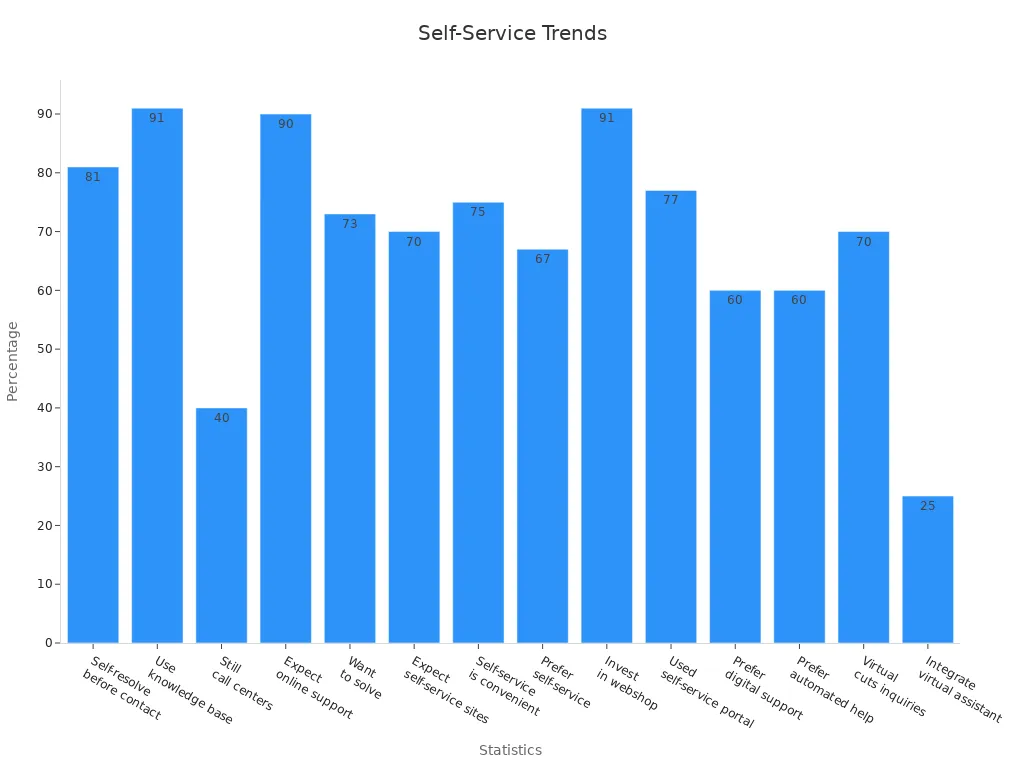
Key Benefits of Self-Service Solutions for Customers

Convenience and 24/7 Accessibility
Imagine needing help late at night or during a busy day. With self-service solutions, you don’t have to wait for business hours or deal with long queues. These tools are available 24/7, giving you instant access to support whenever you need it. Whether it’s checking your account balance, tracking an order, or troubleshooting a product, self-service options make it easy to get things done on your schedule.
Here’s why this matters:
- Self-service solutions eliminate long wait times, letting you resolve issues quickly.
- Around 67% of customers prefer self-service over speaking to an agent, showing how much people value convenience.
- Millennials and Gen Z, who prioritize speed and efficiency, are driving the demand for enhanced customer convenience.

Sobot’s AI Chatbot is a great example. It operates round-the-clock, answering questions and guiding you through processes. Plus, it’s multilingual, so you can interact in your preferred language. This kind of accessibility improves customer experience and ensures you always have the help you need.
Faster Resolutions and Reduced Wait Times
Nobody likes waiting, especially when you’re trying to solve a problem. Self-service tools speed things up by letting you handle issues independently. Instead of waiting for an agent, you can find answers in seconds. This reduction of waiting time is a huge win for customers like you.
Take a look at how self-service improves efficiency:
| Metric | Description |
|---|---|
| Average Resolution Time | Self-service tools resolve issues faster, saving you time. |
| Self-Service Utilization Rate | More customers are choosing self-service options, showing their preference for quick solutions. |
| Self-Service Completion Rate | High completion rates prove that these tools are effective in solving problems. |
| First Contact Resolution Rate (FCR) | Issues resolved on the first try mean fewer follow-ups and faster resolutions. |
| Average First Response Time (FRT) | Immediate responses improve satisfaction and reduce perceived wait times. |
Sobot’s Omnichannel Solution takes this a step further. It integrates tools like chatbots and knowledge bases, ensuring seamless support across platforms. Whether you’re using WhatsApp or email, you’ll experience faster resolutions and improved customer experience.
Empowerment Through Personalized Self-Service Experiences
Self-service isn’t just about convenience—it’s about giving you control. Personalized self-service tools empower you to solve problems independently, boosting your confidence and satisfaction. Imagine browsing a website where product recommendations are tailored to your preferences or using a chatbot that remembers your past interactions. This level of personalization makes you feel valued and engaged.
AI-driven personalization plays a big role here. It adapts to your needs, offering solutions that match your unique situation. For example, Sobot’s AI Chatbot uses smart self-service features to guide you through processes, making interactions smoother and more intuitive. This empowerment fosters loyalty and deeper engagement, turning routine tasks into positive experiences.
Self-service kiosks also contribute to this sense of autonomy. Whether you’re checking in at an airport or ordering food at a restaurant, these kiosks let you take charge of your experience. They’re fast, easy to use, and designed to make your life simpler.
How Sobot’s Chatbot Enhances Customer Self-Service
When you think about customer self-service, you probably imagine tools that make your life easier. Sobot’s AI Chatbot takes this concept to the next level by combining advanced technology with user-friendly features. It’s designed to help you find answers quickly, solve problems independently, and enjoy a seamless experience.
One of the standout features of Sobot’s chatbot is its ability to operate 24/7. Whether it’s the middle of the night or during a busy workday, you can rely on it to provide instant support. It’s multilingual too, so you can interact in your preferred language without any hassle. This accessibility ensures that you always have the help you need, no matter where you are or what time it is.
The chatbot doesn’t just answer questions—it learns from your interactions. By using AI, it personalizes your experience, offering solutions tailored to your specific needs. For example, if you’ve asked about a product before, the chatbot remembers and provides relevant updates. This level of personalization makes you feel valued and understood.
Here’s how Sobot’s chatbot improves customer self-service experiences:
| Metric | Value |
|---|---|
| Increase in agent efficiency | 30% |
| Customer satisfaction score | 97% |
These numbers show how effective the chatbot is. By handling repetitive queries, it frees up human agents to focus on more complex issues. This not only boosts efficiency but also ensures you get faster resolutions. A 97% satisfaction score speaks volumes about how much customers appreciate the convenience and reliability of this tool.
Sobot’s chatbot also helps businesses save money while improving your experience. It automates routine tasks, reducing the need for additional agents. This means businesses can invest more in enhancing the quality of their services. For you, this translates to quicker responses and a smoother journey.
Imagine needing help with a product or service. Instead of waiting on hold or navigating a complicated website, you simply type your question into the chatbot. Within seconds, you have your answer. That’s the power of Sobot’s AI Chatbot—making customer self-service not just possible, but enjoyable.
Key Benefits of Self-Service Solutions for Businesses
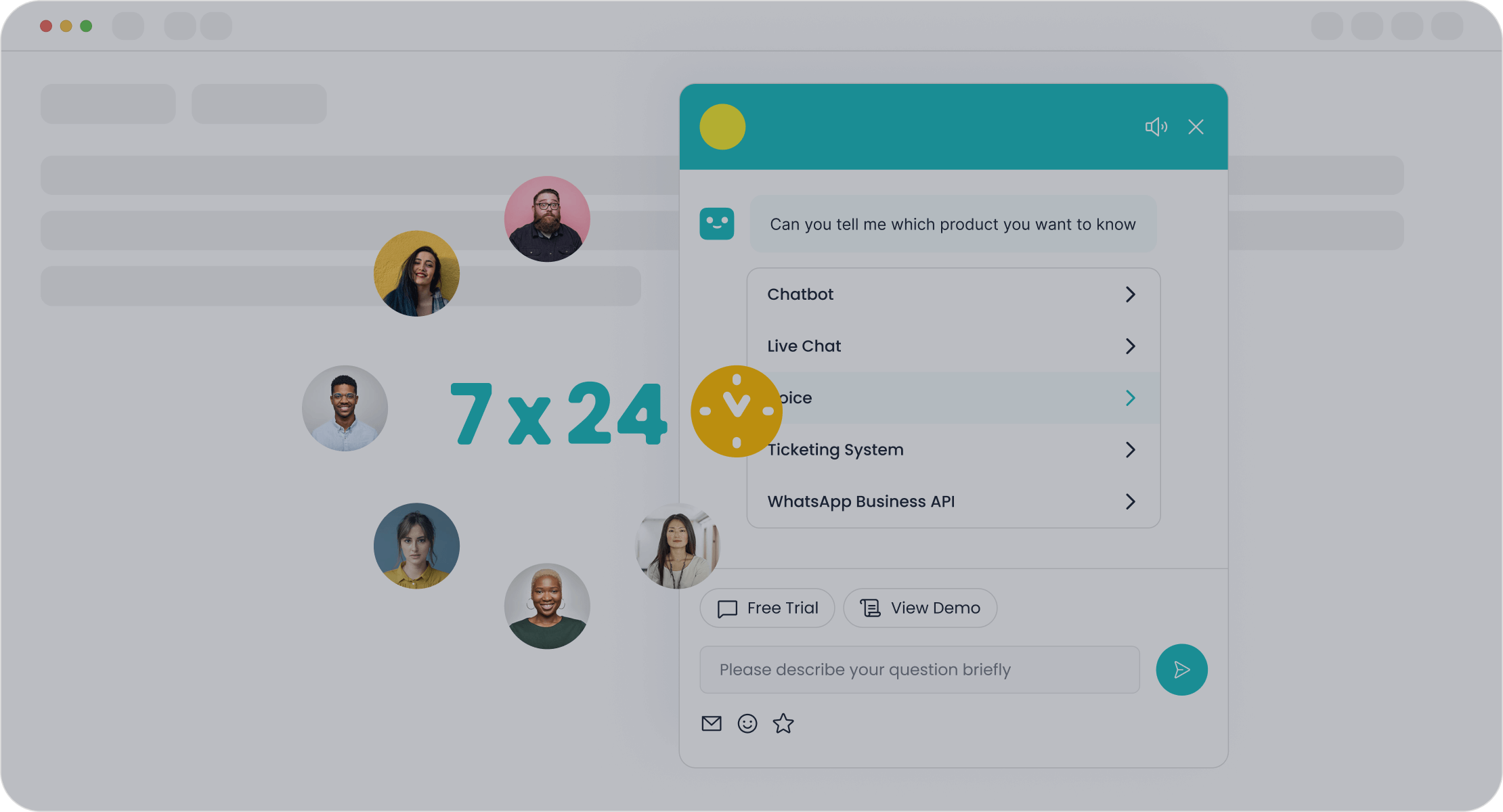
Cost Savings and Operational Efficiency
Self-service solutions aren’t just convenient for customers—they’re a game-changer for businesses like yours. By automating routine tasks, these tools reduce the need for human intervention, saving time and cutting costs. Imagine fewer calls to your support center and more resources available for complex issues. That’s the kind of efficiency self-service technology delivers.
Here’s how it impacts your bottom line:
| Metric | Impact |
|---|---|
| Reduced customer service inquiries | Teams focus on higher-value tasks |
| Lower administrative workloads | Decreases labor costs and staff turnover |
| Savings from reduced call-center volume | 25-30% savings |
| Customer preference for self-service | 67% prefer self-service options |
| Increase in Net Promoter Scores (NPS) | 20% increase in customer loyalty |
| Increase in customer satisfaction | 33% increase |
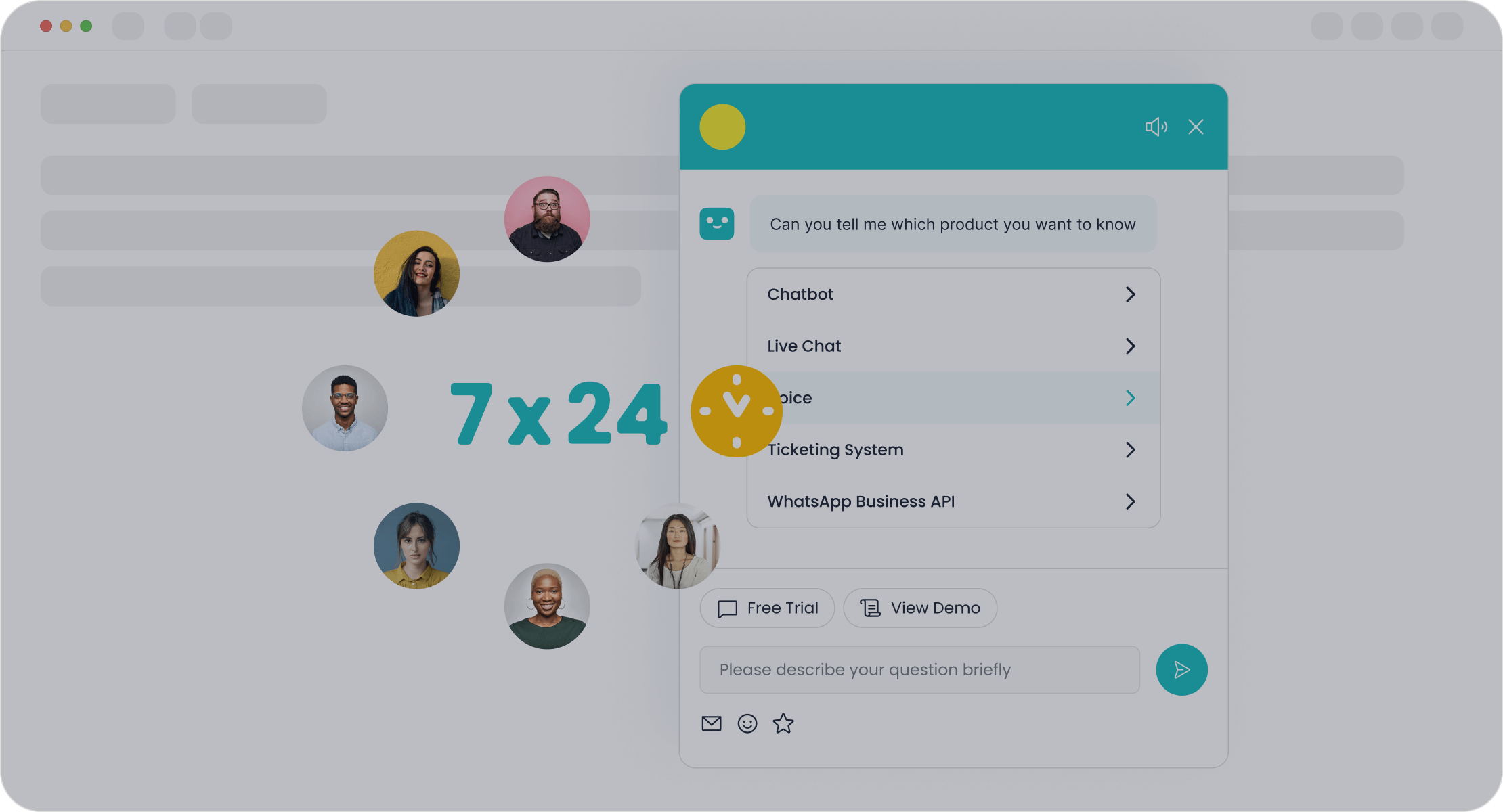
Sobot’s AI Chatbot is a perfect example. It operates 24/7, handling repetitive queries and freeing up your agents to tackle more complex problems. This not only boosts productivity but also leads to a significant reduction in labor costs. Plus, with its multilingual capabilities, it ensures improved service delivery across diverse customer bases.
Scalability to Meet Growing Customer Demands
As your business grows, so do customer expectations. Self-service solutions help you scale effortlessly, ensuring you can meet increasing demands without compromising quality. Tools like AI chatbots and cloud-based systems adapt to real-time needs, making it easier to handle surges in inquiries during peak times.
Here’s what makes self-service technology scalable:
| Evidence Type | Description |
|---|---|
| Rise of Self-Service Options | Customers prefer independent solutions through FAQs and knowledge bases, reducing direct inquiries and enhancing scalability. |
| Automation with AI | AI chatbots handle routine inquiries, reducing the burden on human agents and improving customer satisfaction. |
| Cloud-Based Systems | These systems provide flexibility and scalability, allowing businesses to adapt to real-time demand without infrastructure constraints. |
Dashlane, for instance, achieved a 25% reduction in customer support interactions by implementing interactive self-service guides. Sobot’s Omnichannel Solution takes scalability even further by integrating multiple communication channels into one unified workspace. Whether your customers prefer WhatsApp, email, or live chat, this solution ensures seamless support across platforms.
Enhanced Customer Satisfaction and Retention
Happy customers stick around. Self-service options not only improve efficiency but also enhance the overall customer experience. When customers can resolve issues quickly and independently, they feel empowered and valued. This leads to increased customer satisfaction and long-term loyalty.
Consider these stats:
- Businesses using real-time feedback are 33% more likely to retain customers.
- Over 81% of customers prefer live chat for quick issue resolution.
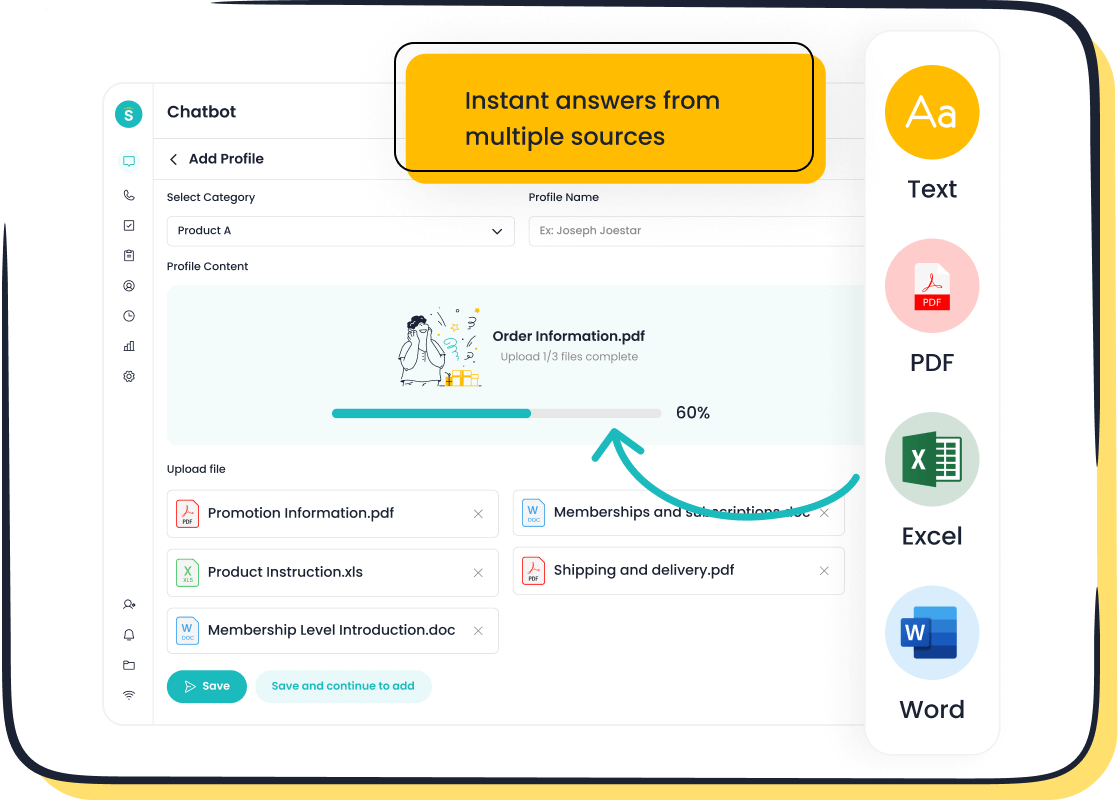
Sobot’s AI Chatbot plays a key role here. By offering faster resolutions and personalized interactions, it boosts satisfaction and retention rates. Its ability to learn from past interactions ensures that customers receive tailored solutions, making every experience feel unique.
Self-service kiosks also contribute to retention by providing time-saving benefits. Whether it’s checking in at an airport or ordering food at a restaurant, these tools make life easier for your customers. The result? Improved efficiency, happier customers, and stronger loyalty.
Leveraging Data Insights for Continuous Improvement
Data is the backbone of any successful self-service strategy. When you use self-service tools, they generate valuable insights that help businesses refine their operations. These insights reveal patterns, customer preferences, and areas for improvement. By analyzing this data, businesses can make smarter decisions and continuously enhance their services.
For example, companies like Hulu and PayPal have leveraged data insights to improve their operations. Hulu uses feedback from analytics tools to refine its user experience, leading to faster insights and better features. PayPal monitors transactions in real-time to detect fraud, ensuring customer safety. These examples show how data can drive meaningful changes.
| Company | Example of Improvement | Impact on Operations |
|---|---|---|
| Hulu | Continuous feedback on analytics tools for improved user experience | Faster insights and refined features |
| General Electric | Sharing equipment performance insights across teams | Optimized efficiency and aligned strategies |
| Gilead Sciences | Unifying siloed data to enhance decision-making | Improved patient outcomes |
| Northmill Bank | Analyzing customer drop-off points | 30% increase in conversion rates |
| PayPal | Real-time transaction monitoring to flag fraudulent activities | Enhanced customer protection |
| General Electric | Analyzing IoT sensor data to predict equipment failures | Proactive maintenance reducing downtime costs |
Sobot’s self-service solutions also excel in this area. Tools like the Sobot AI Chatbot and Omnichannel Solution collect and analyze customer interaction data. This data helps businesses identify common issues, optimize workflows, and improve customer satisfaction. For instance, if customers frequently ask about a specific product feature, businesses can update their knowledge base or chatbot responses to address this need proactively.
By leveraging these insights, you can ensure your self-service tools remain effective and relevant. Continuous improvement isn’t just a goal—it’s a necessity in today’s fast-paced world.
Sobot’s Omnichannel Solution for Streamlined Operations
Managing multiple customer communication channels can feel overwhelming. That’s where Sobot’s Omnichannel Solution comes in. It simplifies the process by unifying all your customer interactions into one platform. Whether your customers reach out via email, WhatsApp, or live chat, you can handle everything seamlessly from a single workspace.
This solution doesn’t just make things easier for you—it also enhances efficiency. By integrating AI-driven automation, it handles repetitive tasks like answering FAQs or routing inquiries to the right department. This frees up your team to focus on more complex issues. In fact, businesses using Sobot’s Omnichannel Solution report a 30% boost in productivity.
Here’s what makes this solution stand out:
- Unified Workspace: Access all customer data and interactions in one place, reducing confusion and improving response times.
- AI-Powered Automation: Automate routine tasks to save time and resources.
- Scalability: Easily adapt to growing customer demands without compromising service quality.
- Data Analytics: Gain actionable insights to optimize your operations and enhance customer satisfaction.
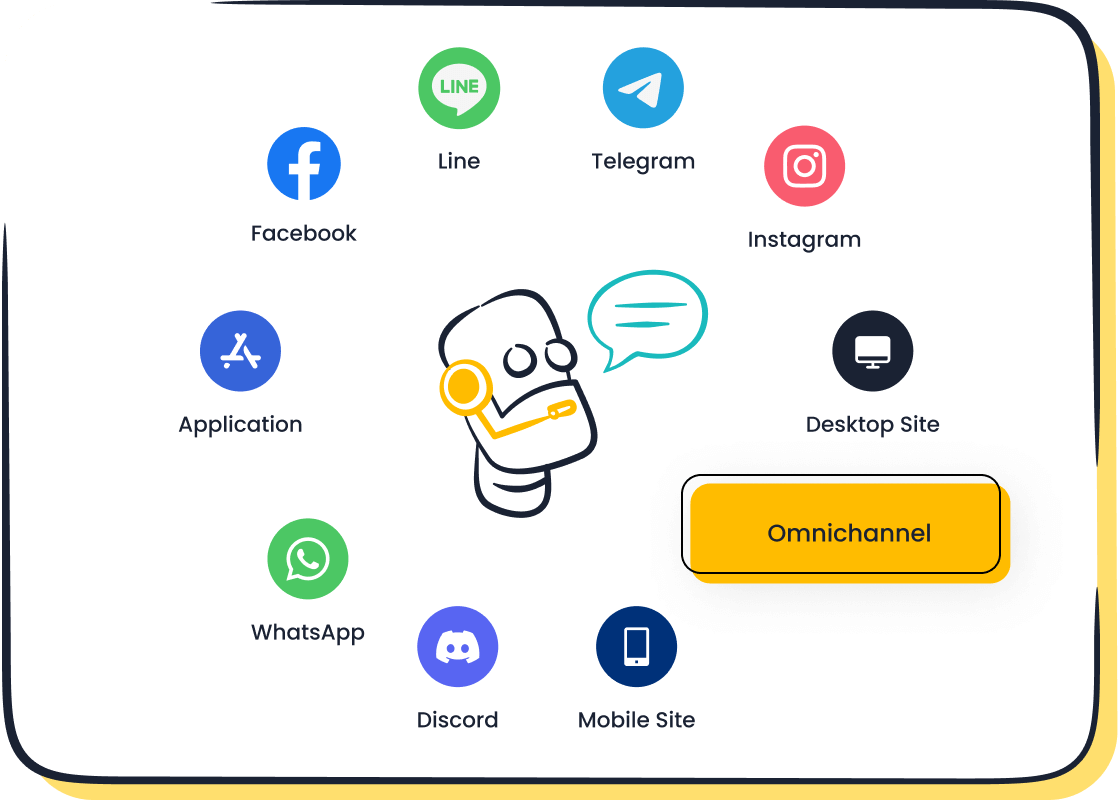
For example, during peak shopping seasons, OPPO used Sobot’s Omnichannel Solution to manage a surge in customer inquiries. By integrating global communication channels and automating repetitive tasks, OPPO improved its chatbot resolution rate to 83% and achieved a 94% positive feedback rate. This streamlined approach not only enhanced customer satisfaction but also boosted operational efficiency.
If you’re looking to streamline business operations, Sobot’s Omnichannel Solution is a game-changer. It’s designed to help you deliver exceptional service while keeping your processes efficient and scalable.
How to Implement Effective Self-Service Solutions
Selecting the Right Self-Service Tools
Choosing the right self-service tools can feel overwhelming, but it’s all about matching your business needs with the right features. Start by evaluating tools based on their ability to empower users and streamline operations. For example, tools like Sobot’s AI Chatbot offer multilingual support and 24/7 availability, making them ideal for businesses with diverse customer bases.
Here’s a quick framework to guide your selection:
| Evaluation Criteria | Description |
|---|---|
| Semantic Modeling Layer | Ensures consistent reporting across departments by defining business metrics centrally. |
| Self-Serve Data Exploration | Empowers users to interact with data independently, enhancing self-service capabilities. |
| Governance | Maintains data security and compliance while monitoring usage patterns. |
| Performance | Ensures responsiveness and optimization as data volumes grow. |
By focusing on these criteria, you can ensure your self-service tools not only meet customer expectations but also scale effectively as your business grows.
Designing an Intuitive and Accessible User Experience
A great self-service experience starts with intuitive design. You want tools that are simple, clear, and easy to navigate. Customers should feel empowered to solve problems without frustration. For instance, Sobot’s chatbot uses a point-and-click interface, eliminating the need for coding and making setup a breeze.
Key design principles include:
- Clarity: Make sure users can easily understand the interface and its functions.
- Consistency: Keep the design uniform across platforms to reduce confusion.
- User Control: Give customers options to personalize their interactions.
Take inspiration from companies like Hulu, which uses analytics to refine its user experience. By focusing on simplicity and familiarity, you can create self-service tools that customers love to use.
Integrating AI-Powered Solutions Like Sobot’s Chatbot
AI-powered solutions like Sobot’s Chatbot are game-changers for self-service platforms. They don’t just answer questions—they learn from interactions to provide personalized support. Imagine a chatbot that remembers your preferences and offers tailored solutions. That’s the kind of experience customers crave.
Here’s what Sobot’s Chatbot delivers:
- Reduction in inbound volume: 20% fewer calls and emails.
- Customer satisfaction rate: 95%, thanks to faster resolutions.
- Problem resolution rate: 85%, ensuring fewer follow-ups.
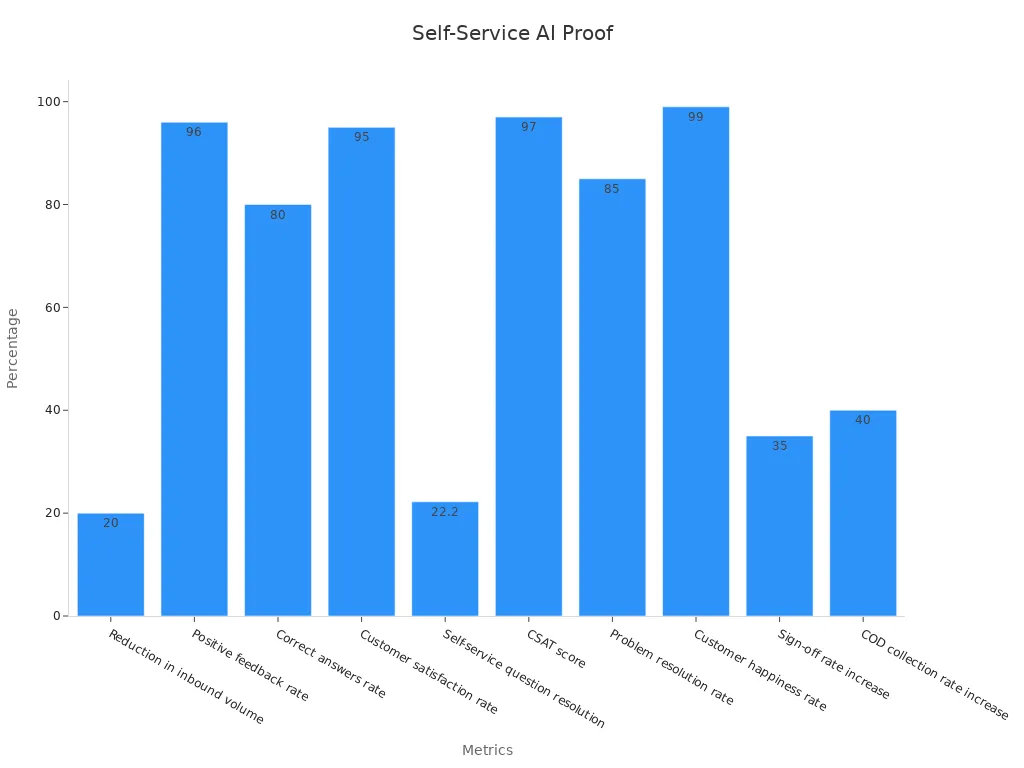
Integrating AI tools like this doesn’t just improve efficiency—it boosts customer happiness. With features like multilingual support and 24/7 availability, Sobot’s Chatbot ensures your customers always have the help they need.
Monitoring Performance and Continuously Optimizing
Self-service solutions aren’t just about setting them up and letting them run. To keep them effective, you need to monitor their performance and tweak them regularly. This ensures they stay efficient, meet customer expectations, and deliver the best results.
Why Monitoring Matters
Tracking how your self-service tools perform gives you valuable insights. You can spot areas where customers struggle, identify drop-off points, and see which features work best. For example, analytics can show if your chatbot is answering questions accurately or if customers are abandoning conversations halfway.
Here’s what you should focus on:
- Bot Automation Score: Measures how well your chatbot handles queries without human help.
- Cost per Automated Chat: Tracks how much you save by automating interactions.
- Customer Sentiment: Analyzes feedback to see how users feel about their experience.
Sobot’s AI Chatbot makes this easy. It provides detailed analytics, helping you pinpoint weak spots and optimize responses. If customers frequently ask about a specific issue, you can update the chatbot’s knowledge base to address it better.
How Optimization Improves Results
Once you’ve identified areas for improvement, it’s time to act. Optimization isn’t just about fixing problems—it’s about making your tools smarter and more efficient. AI-driven insights can help you refine workflows, enhance knowledge bases, and improve response accuracy.
Here’s what optimization achieves:
- Lower Contact Volume: Automating repetitive queries reduces the need for live agents.
- Higher Agent Productivity: Agents can focus on complex issues, boosting efficiency.
- Improved Customer Satisfaction: Better responses lead to happier customers and higher adoption rates.
For example, Sobot’s Omnichannel Solution uses conversation analytics to detect user drop-offs and streamline escalations. This ensures customers get the help they need without frustration.
Tip: Regularly review metrics like response time and resolution rates. Small tweaks can make a big difference in customer satisfaction.
Data-Driven Decision Making
Data isn’t just numbers—it’s a roadmap for success. By analyzing performance metrics, you can make smarter decisions that benefit both your customers and your business. For instance, if analytics show a surge in inquiries during peak hours, you can adjust staffing or enhance self-service tools to handle the load.
Here’s how data helps:
- Enhanced Efficiency: Optimizes scheduling and resource allocation based on demand.
- Strategic Improvements: Provides insights for refining workflows and boosting effectiveness.
- Customer Pain Points: Identifies issues that need immediate attention, improving satisfaction.
Sobot’s solutions excel in this area. They offer actionable insights that help businesses continuously improve their operations. By leveraging these tools, you can ensure your self-service solutions stay ahead of the curve.
Monitoring and optimizing self-service tools isn’t a one-time task. It’s an ongoing process that keeps your operations efficient and your customers happy.
Why Self-Service Solutions Are a Win-Win for Businesses and Customers
Mutual Benefits of Self-Service Solutions
Self-service solutions benefit both customers and businesses in ways that are hard to ignore. For you as a customer, they save time and make life easier. You can check your order status, modify delivery preferences, or initiate returns without waiting for help. For businesses, these tools reduce costs and improve efficiency.
Here’s a quick look at how self-service creates value for everyone:
| Benefit Type | Description |
|---|---|
| Cost Savings | Companies deflected 15% of customer service interactions to self-service options. |
| Improved Customer Satisfaction | Customers can check order status, modify delivery preferences, and initiate returns independently. |
| Increased Efficiency | Self-service checkouts allow companies to enhance operational efficiency when well implemented. |
| Cost Reduction | Companies can reduce costs associated with traditional checkout processes. |
| Time Savings | Self-service reduces administrative strain for customers, saving them time and money. |
| Customer Loyalty | Empowering customers with self-service options encourages repeat business. |
When businesses implement self-service solutions like Sobot’s AI Chatbot, they see these benefits firsthand. The chatbot handles repetitive queries, freeing up agents to focus on complex issues. For you, this means faster resolutions and a better customer experience.
Real-World Success Stories: How Sobot Helped OPPO Transform Customer Service
OPPO’s story shows how self-service can transform customer service. During peak shopping seasons, OPPO faced a surge in inquiries. Long wait times frustrated customers, and agents struggled to keep up. That’s when OPPO turned to Sobot’s solutions.
Sobot’s AI Chatbot stepped in to handle repetitive questions, while human agents focused on complex problems. The chatbot resolved 83% of inquiries, boosting customer satisfaction to 94%. OPPO also optimized its knowledge base with Sobot’s help, cutting maintenance efforts by 90%.
The results were impressive:
- A 57% increase in repurchase rates.
- Faster resolutions and happier customers.
- Streamlined operations across global channels.
This success story highlights how self-service tools like Sobot’s chatbot can improve efficiency and satisfaction for both customers and businesses.
The Role of Self-Service in Building Long-Term Customer Loyalty
Self-service doesn’t just solve problems—it builds loyalty. When you can access information easily and manage loyalty programs independently, you feel empowered. This convenience encourages you to stick with brands that make your life simpler.
Here’s how self-service drives loyalty:
- Self-service tools provide valuable information while capturing customer behavior data.
- Loyalty management systems let you monitor and maximize program benefits.
- Data-driven loyalty programs lead to 12-18% more revenue growth annually.
Companies that analyze loyalty program performance see better retention rates. Members of these programs spend 2-3 times more than non-members. Sobot’s solutions help businesses leverage data insights to refine loyalty strategies. By empowering you with self-service options, they create experiences that keep you coming back.
Tip: Brands that prioritize self-service tools see higher satisfaction and stronger loyalty.
Self-service solutions are transforming how businesses and customers interact. They offer unmatched benefits, from reducing support costs to enhancing customer satisfaction. For customers, these tools provide convenience, allowing them to resolve issues independently and on their own schedule. Businesses, on the other hand, gain efficiency, scalability, and valuable data insights to improve operations.
Take a look at how these solutions create value:
| Benefit | Description |
|---|---|
| Enhanced Customer Convenience | Customers can access information or perform actions at their own pace, avoiding wait times. |
| Reduced Support Costs | Fewer incoming queries lead to lower operational costs and better resource allocation. |
| Improved Efficiency | Streamlined support processes result in faster issue resolution times for customers. |
| Increased Customer Satisfaction | Positive experiences foster loyalty and encourage repeat business. |
| Greater Scalability | Self-service tools can handle increased demand without needing proportional staff increases. |
| Data-Driven Insights | Analyzing self-service interactions helps identify common issues and improve resources. |
By leveraging tools like Sobot’s AI Chatbot and Omnichannel Solution, businesses can deliver faster resolutions and personalized experiences. These solutions empower customers while optimizing operations, making them essential for modern customer service strategies.
Tip: Businesses that embrace self-service solutions not only save costs but also build stronger, long-term relationships with their customers.
FAQ
What are self-service solutions, and why are they important?
Self-service solutions let you handle tasks like finding answers or completing transactions without needing help. They’re important because they save time, reduce costs, and improve customer satisfaction. For example, Sobot’s AI Chatbot operates 24/7, empowering you to solve problems anytime.
How do self-service tools benefit businesses?
Self-service tools reduce costs, improve efficiency, and enhance customer satisfaction. For instance, Sobot’s Omnichannel Solution automates repetitive tasks, freeing agents to focus on complex issues. Businesses using these tools report up to a 30% boost in productivity and higher customer loyalty.
Can self-service solutions handle complex customer needs?
Yes, advanced tools like Sobot’s AI Chatbot use AI to address complex queries. They learn from interactions and provide personalized solutions. If a chatbot can’t resolve an issue, it seamlessly escalates it to a human agent, ensuring you always get the help you need.
Are self-service solutions scalable for growing businesses?
Absolutely! Self-service tools like Sobot’s Omnichannel Solution adapt to growing customer demands. They integrate multiple communication channels, ensuring seamless support during peak times. This scalability helps businesses maintain quality service without increasing staff.
How does Sobot ensure a great self-service experience?
Sobot combines AI-driven tools like its Chatbot and Omnichannel Solution to deliver fast, personalized support. Features like 24/7 availability, multilingual support, and data analytics ensure you get quick resolutions while businesses optimize operations for better service.
See Also
Continuous Live Chat Assistance Enhances Business Growth
Key Advantages of Integrating Chatbots on Websites
Enhance SaaS Customer Support Using Live Chat Techniques
Ways AI Customer Service Tools Improve Operational Efficiency
Increasing E-commerce Customer Satisfaction Through Chatbot Use
